東京大学大学院 理学系研究科物理学専攻 理学部物理学科
中辻・酒井 研究室
Department of Physics, Graduate School of Science and Faculty of Science, The University of Tokyo
Nakatsuji・Sakai Laboratory
The world has shifted,
Yet still, I am who I am
Oath of symmetry
Topology – the mathematical concept that characterizes the robustness of forms under continuous deformation, has opened up a new chapter in the story of quantum materials. The traditional framework for classifying phases and phase transitions follows the Landau theory of spontaneous symmetry breaking, a must-cover topic in statistical mechanics textbooks. This framework works beautifully in describing a zoo of phenomena, ranging from the boiling and freezing of water to superconductivity and superfluidity; however, a broad class of “misfits” – the topological phases, exposes its limitation. A well-known example is the quantum Hall effect, where the transition between electron states of distinct integer Hall conductance does not break any symmetry. Further research efforts reveal that the topological phases are rooted in the “shape” of the electron band and are protected by the underlying symmetries. Taking topology as the guiding principle, a new paradigm for classifying quantum phases emerges, which fuels the exploration of novel states of matter that are not only of fundamental interest but may hold potential technological applications.
In our lab, the experimental journey in the topological realm leads us to discoveries of quantum transport phenomena that defy the common sense. One such prime finding is the surprisingly large anomalous Hall effect (AHE) in non-ferromagnetic materials, namely, spin liquids and antiferromagnets. The AHE, where voltage flows transversely to the current direction without external magnetic field, is one of the most fundamental and widely-studied transport phenomena in physics. Traditionally, the AHE is considered to be proportional to net magnetization, and therefore, is expected to occur only in ferromagnets. Later theoretical advances have established an intimate connection between the AHE and the Berry curvature – a virtual magnetic field in the momentum space that serves as an indicator of the electron band topology. We design materials that feature unique topological state with strongly enhanced Berry curvature, leading to significant AHE despite the absence of net magnetization. The observed AHE enables us to electrically manipulate and detect antiferromagnetically coupled spins, giving rise to a new direction for realizing memory devices that are much faster and energy-efficient than today’s version. For more details on this research topic, please refer to the following list of publications.
[1] Y. Machida et al., Nature 463, 210 (2010).
[2] S. Nakatsuji, N. Kiyohara, and T. Higo, Nature 527, 212 (2015).
[3] N. Kiyohara, T. Tomita, and S. Nakatsuji, Phys. Rev. Applied 5, 064009 (2016).
[4] K. Kuroda, T. Tomita et al., Nat. Mater. 16, 1090 (2017).
[5] M.-T. Suzuki et al., Phys. Rev. B 95, 094406 (2017).
[6] M. Ikhlas, T. Tomita et al., Nat. Phys. 13, 1085 (2017).
[7] T. Higo et al., Nat. Photon. 12, 73 (2018).
[8] H. Tsai, T. Higo et al., Nature 580, 608 (2020).
[9] T. Higo K. Kondou et al., Nature 607, 474 (2022).
[10] A. Sakai, et al., Nat. Phys. 14, 1119 (2018).
[11] A. Sakai, S. Minami, T. Koretsune, T. Chen, T. Higo et al., Nature 581, 53 (2020).
[12] T. Higo et al., Adv. Funct. Mater. 2008971 (2021).
[13] H. Tanaka, T. Higo et al., Adv. Mater. 2303416 (2023).
[14] R. Uesugi, T. Higo, S. Nakatsuji, Appl. Phys. Lett. 123, 252401 (2023).
Quantum transport phenomena in topological materials
Highlights
Robust giant anomalous Nernst effect in polycrystalline nodal web ferromagnets
Y. Wang, A. Sakai, S. Minami, H. Gu, T. Chen, Z. Feng, D. Nishio-Hamane, S. Nakatsuji, Appl. Phys. Lett. 125, 081901 (2024).
The transverse thermoelectric effect based on the anomalous Nernst effect (ANE) has attracted attention, especially for thermoelectric and spintronic applications. Fe3X (X = Ga, Al) is known to exhibit a large ANE at room temperature owing to the topological electronic band structure so-called nodal web. Here, we systematically investigate ANE in the polycrystalline Fe3Ga1−xAlx and Fe3Al1−xSix. Despite significant chemical substitutions, a very robust feature of the large ANE −Syx∼ 5.7 μ V/K is found for Fe3Ga1−xAlx (0≲x≲0.6), exhibiting a striking x independent nodal web contribution. Since aluminum is more low-cost and abundant than gallium, our results indicate Fe3Ga1−xAlx (x∼0.6) should be suitable for large-scale thermoelectric applications.

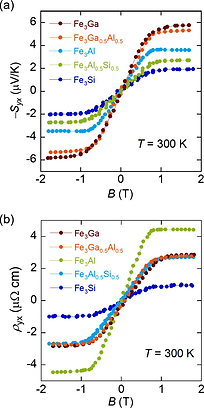
Large spontaneous magneto-thermoelectric effect in epitaxial thin films of the topological kagome ferromagnet Fe3Sn
S. Kurosawa, T. Higo, S. Saito, R. Uesugi, S. Nakatsuji,
Phys. Rev. Materials 8, 054206 (2024). (Editors' Suggestion, Featured in Physics)
Recent intensive studies in metallic kagome systems have revealed various correlated topological and electronic states, leading to their spintronic applications. The kagome ferromagnetic metal Fe3Sn has been found to host a topological nodal plane near the Fermi energy and exhibits large transverse transport responses. Here we report the fabrication of the epitaxial thin films of Fe3Sn and the observation of its large anomalous Nernst effect (ANE). Structural and magnetic measurements reveal (0001)-orientated epitaxial growth of kagome 𝐷019 Fe3Sn and the magnetic easy plane along the substrate plane. Moreover, transport measurements confirm the large ANE of 2.4 µV/K at room temperature, comparable to that of the bulk polycrystalline samples. The obtained Fe3Sn film should be useful for thermoelectric applications, because the binary compound based on inexpensive elements exhibits large spontaneous ANE voltage under an out-of-plane heat current due to the magnetic and electronic states stabilized by the magnetic anisotropy.

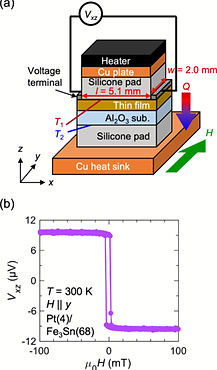
©2024 American Physical Society
Anisotropic anomalous transport in the kagome-based topological antiferromagnetic Mn3Ga epitaxial thin films
M. Raju, R. Romero, III, D. Nishio-Hamane, R. Uesugi, M. Asakura, Z. Tagay, T. Higo, N. P. Armitage, C. Broholm, S. Nakatsuji
Phys. Rev. Materials 8, 014204 (2024). (Editors' Suggestion)
Mn3X (X=Sn, Ge, Ga) kagome Weyl semimetals have attracted significant research interest due to their large anomalous Hall, thermal, and optical effects originating from their nontrivial band topology. These large topological effects together with the antichiral antiferromagnetic order that can be manipulated through various experimental means provide unique platforms for developing high-speed spintronics. Mn3Ga is known to have the largest Néel temperature (TN≈480 K), which is useful for developing antiferromagnetic spintronics. Here, we establish the epitaxial growth of antiferromagnetic Mn3Ga films by magnetron sputtering and present their structure, magnetotransport, terahertz properties, and exchange bias effect in Mn3Ga/NiFe bilayers, establishing their remarkable properties essential for future investigations towards device applications.
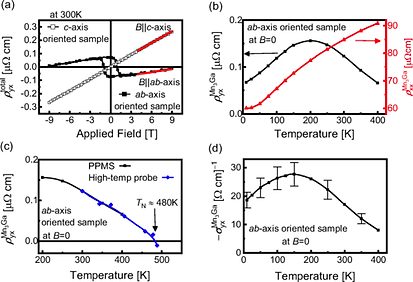
©2024 American Physical Society
Giant anomalous Nernst effect in polycrystalline thin films of the Weyl ferromagnet Co2MnGa
R. Uesugi, T. Higo, S. Nakatsuji, Appl. Phys. Lett. 123, 252401 (2023).
Recent discoveries of topological magnets have opened up diverse spintronic applications of large responses due to their unique band structures. A prominent example is the anomalous Nernst effect (ANE), a transverse magneto-thermoelectric phenomenon that produces an electromotive force orthogonal to the heat flux and magnetization. Unlike the Seebeck effect generating an electromotive force parallel to the heat flux, transverse thermoelectric properties of ANE well fit in the lateral configurations of devices fabricated through conventional thin-film fabrication processes. This feature enables distinct device applications through a simplified fabrication process, reduced production cost, extensive area coverage, and enhanced flexibility. In this study, we report the highest ANE ever recorded among all reported polycrystalline films to date by using a topological ferromagnet. In particular, we have fabricated high-quality polycrystalline thin films of the Weyl ferromagnet Co2MnGa that exhibit a large ANE of − 5.4 μV/K. By retaining a high film density, we demonstrate the sizable ANE in the films obtained using a simple fabrication process well suited for device developments. Establishing a thin-film fabrication technique capable of producing a giant ANE facilitates spintronic applications of the Weyl ferromagnet, including diverse ANE-based device applications.

Giant and Robust Anomalous Nernst Effect in a Polycrystalline Topological Ferromagnet at Room Temperature
Z. Feng, S. Minami, S. Akamatsu, A. Sakai, T. Chen, D. Nishio-Hamane, S. Nakatsuji, Adv. Funct. Mater. 32, 2206519 (2022).
Recent discoveries of the topological magnets have opened a new path for developing a much simpler thermoelectric conversion module using the anomalous Nernst effect (ANE). To accelerate such innovation, it is essential to design materials suitable for industrial processes, and thus a high-ANE polycrystalline material has been highly desired. Recently, the giant room-temperature ANE has been reported in single crystals of the topological ferromagnet Fe3Ga. Owning to its cubic structure, the anomalous Hall effect and ANE are isotropic. These properties potentially allow to employ a polycrystalline form of the material to design an ANE-based thermopile. Here, a giant and robust room-temperature ANE in the polycrystalline FexGa4−x (2.96 < x < 3.15) is reported, which can be enhanced up to 5.4 µV K−1; this value hits the highest room-temperature record for polycrystalline magnets. Comparison of the experimental results with the theoretical study of the Fe-doping effect on the transport properties of FexGa4−x reveals that the Fermi energy tuning near the topological nodal-web structure is the key to enhancing the ANE. Moreover, the large value of more than 5.1 µV K−1 is observed for an extended region of composition, confirming the robust characteristics of the topological electronic structure.

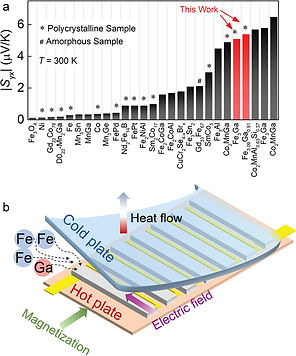
© 2022 Wiley-VCH GmbH
Large anomalous Nernst effect and nodal plane in an iron-based kagome ferromagnet
T. Chen, S. Minami, A. Sakai, Y. Wang, Z. Feng, T. Nomoto, M. Hirayama, R. Ishii, T. Koretsune, R. Arita, S. Nakatsuji,
Sci. Adv. 8, eabk1480 (2022).
Anomalous Nernst effect (ANE), converting a heat flow to transverse electric voltage, originates from the Berry phase of electronic wave function near the Fermi energy EF. Thus, the ANE provides a sensitive probe to detect a topological state that produces large Berry curvature. In addition, a magnet that exhibits a large ANE using low-cost and safe elements will be useful to develop a novel energy harvesting technology. Here, we report our observation of a high ANE exceeding 3 microvolts per kelvin above room temperature in the kagome ferromagnet Fe3Sn with the Curie temperature of 760 kelvin. Our theoretical analysis clarifies that a “nodal plane” produces a flat hexagonal frame with strongly enhanced Berry curvature, resulting in the large ANE. Our discovery of the large ANE in Fe3Sn opens the path for the previously unexplored functionality of flat degenerate electronic states and for developing flexible film thermopile and heat current sensors.
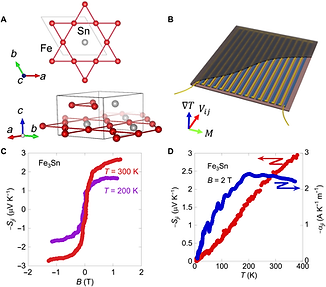
Copyright © 2022 The Authors, some rights reserved (CC BY-NC)
Logarithmic criticality in transverse thermoelectric conductivity of the ferromagnetic topological semimetal CoMnSb
H. Nakamura, S. Minami, T. Tomita, A. A. Nugroho, S. Nakatsuji, Phys. Rev. B 104, L161114 (2021).
We report the results of our experimental studies on the magnetic, transport, and thermoelectric properties of the ferromagnetic metal CoMnSb. A sizable anomalous Hall conductivity σyx and transverse thermoelectric conductivity αyx are found experimentally and comparable in size to the values estimated from first-principles calculation. Our experiment further reveals that CoMnSb exhibits −TlogT critical behavior in αyx(T), deviating from Fermi liquid behavior αyx∼T over a decade of temperature between 10 and 400 K, similar to ferromagnetic Weyl and nodal-line semimetals. Our theoretical calculation for CoMnSb also predicts the −TlogT behavior when the Fermi energy locates near the Weyl nodes in momentum space.
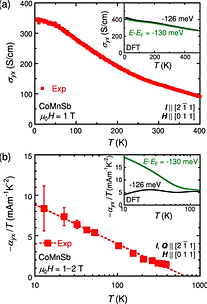
©2021 American Physical Society
Iron-based binary ferromagnets for transverse thermoelectric conversion
A. Sakai, S. Minami, T. Koretsune, T. Chen, T. Higo, Y. Wang, T. Nomoto, M. Hirayama, S. Miwa, D. Nishio-Hamane, F. Ishii, R. Arita, S. Nakatsuji, Nature 581, 53 (2020).
Thermoelectric generation using the anomalous Nernst effect (ANE) has great potential for application in energy harvesting technology because the transverse geometry of the Nernst effect should enable efficient, large-area and flexible coverage of a heat source. For such applications to be viable, substantial improvements will be necessary not only for their performance but also for the associated material costs, safety and stability. In terms of the electronic structure, the anomalous Nernst effect (ANE) originates from the Berry curvature of the conduction electrons near the Fermi energy. To design a large Berry curvature, several approaches have been considered using nodal points and lines in momentum space. Here we perform a high-throughput computational search and find that 25 percent doping of aluminium and gallium in alpha iron, a naturally abundant and low-cost element, dramatically enhances the ANE by a factor of more than ten, reaching about 4 and 6 microvolts per kelvin at room temperature, respectively, close to the highest value reported so far. The comparison between experiment and theory indicates that the Fermi energy tuning to the nodal web—a flat band structure made of interconnected nodal lines—is the key for the strong enhancement in the transverse thermoelectric coefficient, reaching a value of about 5 amperes per kelvin per metre with a logarithmic temperature dependence. We have also succeeded in fabricating thin films that exhibit a large ANE at zero field, which could be suitable for designing low-cost, flexible microelectronic thermoelectric generators.
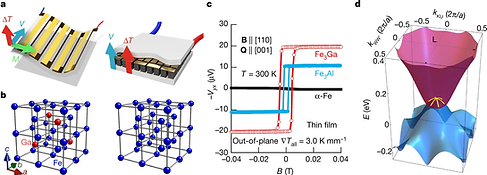
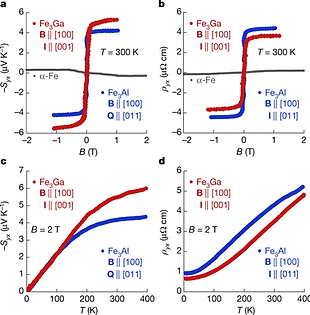
© The Author(s), under exclusive licence to Springer Nature Limited 2020
